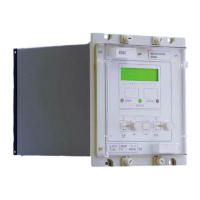Manual
KVCG202/EN M/H
9.9.1 Preliminary checks
Loosen the four cover screws and remove the cover, the relay can now be withdrawn
from its case. Carefully examine the module and case to see that no damage has
occurred since installation and visually check the current transformer shorting switches in
the case are wired into the correct circuit and are closed when the module is withdrawn.
Check that the serial number on the module, case and front plate are identical and that
the model number and rating information are correct.
Check that the external wiring is correct to the relevant relay diagram or scheme diagram.
The relay diagram number appears inside the case on a label at the left hand side. The
serial number of the relay also appears on this label, and on the front plate of the relay
module. The serial numbers marked on these three items should match; the only time
that they may not match is when a failed relay module has been replaced for continuity of
protection.
With the relay removed from its case, ensure that the shorting switches between
terminals listed below are closed by checking with a continuity tester.
Terminals: 21 and 22; 23 and 24; 25 and 26; 27 and 28.
9.9.1.1 Earthing
Ensure that the case earthing connection, above the rear terminal block, is used to
connect the relay to a local earth bar and where there is more than one relay the copper
earth bar is in place connecting the earth terminals of each case in the same tier
together.
9.9.1.2 Main current transformers
DO NOT OPEN CIRCUIT THE SECONDARY CIRCUIT OF A LIVE CT SINCE THE HIGH
VOLTAGE PRODUCED MAY BE LETHAL TO PERSONNEL AND COULD DAMAGE
INSULATION.
9.9.2 Remote testing
The relay can be communicated with from a remote point, via its serial port, then some
testing can be carried out without actually visiting the site.
9.9.2.1 Alarms
The alarm status led should first be checked to identify if any alarm conditions exist. The
alarm records can then be read to identify the nature of any alarm that may exist.
9.9.2.2 Measurement accuracy
The values measured by the relay can be compared with known system values to check
that they are in the approximate range that is expected. If they are, then the
analogue/digital conversion and calculations are being performed correctly.
9.9.3 Local testing
When testing locally, similar tests may be carried out to check for correct functioning of
the relay.
9.9.3.1 Alarms
The alarm status led should first be checked to identify if any alarm conditions exist. The
alarm records can then be read to identify the nature of any alarm that may exist.
9.9.3.2 Measurement accuracy
The values measured by the relay can be checked against known values injected into the
relay via the test block, if fitted, or injected directly into the relay terminals. Suitable test
methods will be found in Section 8.1 of this manual which deals with commissioning.
These tests will prove the calibration accuracy is being maintained.
9.9.3.3 Additional tests
Additional tests can be selected only from the features that are to be used in the
application these features are listed in the Commissioning test instructions as required.

